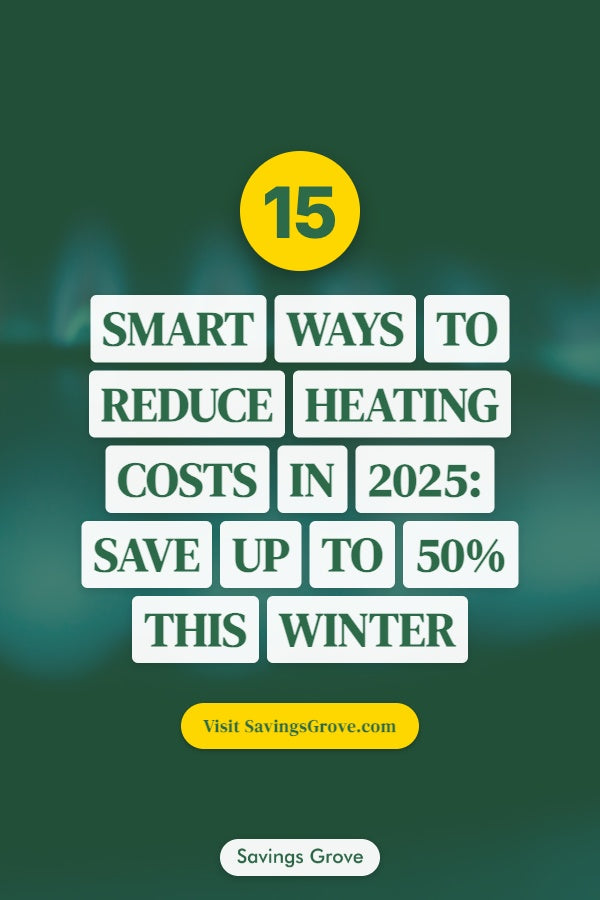
With energy prices continuing to rise, learning how to reduce heating costs has become more important than ever.
15 Smart Ways to Reduce Heating Costs in 2025: Save Up to 50% This Winter
This comprehensive guide will show you practical ways to lower your heating bills while keeping your home comfortable. From simple DIY solutions to smart home investments, these tips can help you save hundreds of dollars annually.
1. Install a Smart Thermostat
A smart thermostat can reduce heating costs by 10-15% annually. Popular models like the Nest Learning Thermostat ($249) or the more budget-friendly Amazon Smart Thermostat ($79) can quickly pay for themselves through energy savings. Check out our guide on smart thermostat savings for more details.
2. Seal Air Leaks Around Windows and Doors
Weather stripping and door sweeps cost $5-20 per unit but can save up to 15% on heating costs. Use caulk for small gaps ($5-10 per tube) and foam sealant for larger ones ($5-15 per can).
3. Upgrade Your Insulation
Adding proper insulation to your attic can reduce heating costs by 15-20%. Professional installation costs $1,500-2,500 but often qualifies for energy efficiency tax credits.
4. Service Your Heating System Regularly
Annual HVAC maintenance ($80-200) can improve efficiency by 5-10%. Consider a maintenance plan from your utility provider for discounted rates.
5. Use Programmable Settings
Program your thermostat to lower temperatures while you're asleep or away. Every degree lower for 8 hours can save 1% on your heating bill.
6. Replace or Clean Air Filters
Clean filters ($10-30) every 1-3 months to maintain efficiency. A dirty filter can increase energy consumption by 15%.
7. Utilize Solar Heat Gain
Open curtains on south-facing windows during the day and close them at night to retain heat. This zero-cost strategy can reduce heating needs by 5-10%.
8. Add Window Treatments
Thermal curtains ($20-50 per panel) or cellular shades ($30-100 per window) can reduce heat loss by up to 40%.
9. Use Space Heaters Strategically
Energy-efficient space heaters ($50-150) can save money by heating only occupied rooms while keeping the central heating lower.
10. Install Door Draft Stoppers
Draft stoppers ($10-20) can prevent cold air infiltration under doors, potentially saving 5% on heating costs.
11. Optimize Humidity Levels
Maintain 30-50% humidity with a humidifier ($30-100). Proper humidity makes air feel warmer, allowing lower thermostat settings.
12. Reverse Ceiling Fans
Run ceiling fans clockwise in winter to push warm air down. This can reduce heating costs by 5-10% at no additional cost.
13. Get an Energy Audit
Professional energy audits ($200-700) can identify specific areas for improvement. Many utility companies offer free or discounted audits - check our guide on saving money on utility bills.
14. Insulate Hot Water Pipes
Pipe insulation ($2-5 per 6 ft.) can reduce heat loss and water heating costs by 5-10%.
15. Consider a Heat Pump
Modern heat pumps can reduce heating costs by 50% compared to electric resistance heating. While installation costs $4,000-8,000, federal tax credits can cover up to 30% of the cost.
Final Words
Implementing these heating cost reduction strategies requires some upfront investment but can lead to significant long-term savings. For more money-saving tips, check out our guide on energy saving tips for apartments. Start with the most cost-effective solutions and gradually implement others as your budget allows.
Related Articles
Frequently Asked Questions About Reducing Heating Costs
What temperature should I set my thermostat to save money in winter?
The U.S. Department of Energy recommends setting your thermostat to 68°F (20°C) while you're awake and at home, and lowering it by 7-10°F when you're asleep or away. Every degree lower for 8 hours can save about 1% on your annual heating costs.
Are smart thermostats worth the investment?
Yes, smart thermostats are typically worth the investment. While they cost $80-250 upfront, they can reduce heating costs by 10-15% annually, meaning they usually pay for themselves within 1-2 years. Many utility companies also offer rebates for smart thermostat installations.
What's the most cost-effective way to heat a home?
Heat pumps are generally the most cost-effective heating solution, especially in moderate climates. They can reduce heating costs by up to 50% compared to electric resistance heating. For homes with access to natural gas, a high-efficiency gas furnace can also be very cost-effective. Supplementing with space heaters in occupied rooms while keeping the main thermostat lower can also reduce overall heating costs.
How much can insulation save on heating costs?
Proper insulation can reduce heating costs by 15-20% on average. The savings can be even higher in older homes with poor existing insulation. While professional insulation installation costs $1,500-2,500, the investment typically pays for itself within 3-5 years through reduced energy bills.

